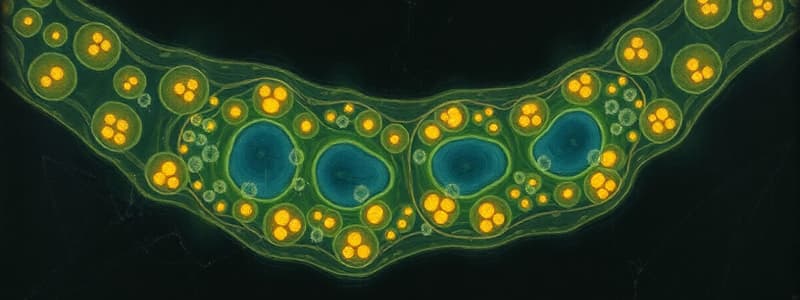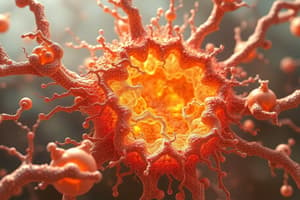Podcast
Questions and Answers
Which of the following ions can pass through gap junction channels?
Which of the following ions can pass through gap junction channels?
- Iron
- Oxygen
- Carbon Dioxide
- Potassium (K+) (correct)
Connexins are only expressed in vertebrates.
Connexins are only expressed in vertebrates.
False (B)
What is a primary function of gap junctions in the brain?
What is a primary function of gap junctions in the brain?
- To produce neurotransmitters
- To create a blood-brain barrier
- To store electrical impulses
- To enable direct cell-to-cell communication (correct)
What percentage of channels at gap junctions are conductive?
What percentage of channels at gap junctions are conductive?
Electrical synapses are slower than chemical synapses in transmitting signals.
Electrical synapses are slower than chemical synapses in transmitting signals.
Gap junction channels allow the passage of ____________ and small organic molecules.
Gap junction channels allow the passage of ____________ and small organic molecules.
What is the significance of connexins in the structure of gap junctions?
What is the significance of connexins in the structure of gap junctions?
Match the connexin type with its primary role or characteristic:
Match the connexin type with its primary role or characteristic:
What is the primary function of gap junctions?
What is the primary function of gap junctions?
The failure of electrical synapses can lead to deficits in the __________ of Cx36 knockout mice.
The failure of electrical synapses can lead to deficits in the __________ of Cx36 knockout mice.
Match the following characteristics with their respective types of synapses:
Match the following characteristics with their respective types of synapses:
Co-expression of different connexins can lead to complex subunit assemblies.
Co-expression of different connexins can lead to complex subunit assemblies.
How many connexin genes are expressed in the human genome?
How many connexin genes are expressed in the human genome?
What are gap junctions composed of?
What are gap junctions composed of?
Mutations in connexins can lead to ______ disorders such as cataracts and hearing impairment.
Mutations in connexins can lead to ______ disorders such as cataracts and hearing impairment.
Match the connexins with the disorders they are associated with:
Match the connexins with the disorders they are associated with:
Which of the following cell types has been shown to express connexins?
Which of the following cell types has been shown to express connexins?
Electrical synapses were discovered in 1967.
Electrical synapses were discovered in 1967.
Which year was gap junctions discovered?
Which year was gap junctions discovered?
The hexagonal array of subunits in gap junctions is critical for __________ transfer between cells.
The hexagonal array of subunits in gap junctions is critical for __________ transfer between cells.
What physiological role do electrical synapses play?
What physiological role do electrical synapses play?
What primarily composes most electrical synapses in mammals?
What primarily composes most electrical synapses in mammals?
Electrical synapses are typically unidirectional in their ionic current transmission.
Electrical synapses are typically unidirectional in their ionic current transmission.
What is the role of Cx36 in the brain?
What is the role of Cx36 in the brain?
Most electrical synapses in mammals are comprised of ______.
Most electrical synapses in mammals are comprised of ______.
What type of neurons does Cx36 typically couple?
What type of neurons does Cx36 typically couple?
Match the following terms with their descriptions:
Match the following terms with their descriptions:
What has been demonstrated through studies in the Cx36 knockout mouse?
What has been demonstrated through studies in the Cx36 knockout mouse?
Electrical synapses can only allow large molecules to pass between cells.
Electrical synapses can only allow large molecules to pass between cells.
How does synchrony generated by electrical synapses affect the brain?
How does synchrony generated by electrical synapses affect the brain?
Electrical synapses and ______ together generate complex electrical activity in the brain.
Electrical synapses and ______ together generate complex electrical activity in the brain.
What is the primary protein that composes electrical synapses in the brain?
What is the primary protein that composes electrical synapses in the brain?
Electrical synapses show preference for depolarizing responses.
Electrical synapses show preference for depolarizing responses.
What is the coupling coefficient in the context of electrical synapses?
What is the coupling coefficient in the context of electrical synapses?
Gap junctions are primarily composed of proteins known as __________.
Gap junctions are primarily composed of proteins known as __________.
Match the following proteins to their type:
Match the following proteins to their type:
What type of synapse is characterized by the ability to pass subthreshold current?
What type of synapse is characterized by the ability to pass subthreshold current?
Spikelets are the result of action potentials in electrical synapses.
Spikelets are the result of action potentials in electrical synapses.
What is one advantage of using dye coupling to assay electrical synapses?
What is one advantage of using dye coupling to assay electrical synapses?
Electrical synapses are described as __________, meaning they allow communication in both directions.
Electrical synapses are described as __________, meaning they allow communication in both directions.
What is a limitation of dual cell electrophysiology in studying electrical synapses?
What is a limitation of dual cell electrophysiology in studying electrical synapses?
Flashcards
Gap junctions
Gap junctions
Intercellular channels composed of connexins, allowing the passage of ions, small molecules, and metabolites between cells.
Connexins
Connexins
Protein subunits that form the channels of gap junctions.
Gap Junction Channels
Gap Junction Channels
Permeable channels that allow passage of inorganic ions, small organic molecules, dyes, and metabolites between cells.
Connexon
Connexon
Signup and view all the flashcards
Coordination of cellular activity
Coordination of cellular activity
Signup and view all the flashcards
Electrical transmission
Electrical transmission
Signup and view all the flashcards
Cx36 Gap Junctions
Cx36 Gap Junctions
Signup and view all the flashcards
Intercellular communication
Intercellular communication
Signup and view all the flashcards
Electrical Synapses
Electrical Synapses
Signup and view all the flashcards
Cx36
Cx36
Signup and view all the flashcards
Interneurons
Interneurons
Signup and view all the flashcards
Homocellular Assemblies
Homocellular Assemblies
Signup and view all the flashcards
Brain Rhythms
Brain Rhythms
Signup and view all the flashcards
Knockout Mouse
Knockout Mouse
Signup and view all the flashcards
Motor Impairment
Motor Impairment
Signup and view all the flashcards
Cerebellar Circuitry
Cerebellar Circuitry
Signup and view all the flashcards
Electrical vs. Chemical Synapses
Electrical vs. Chemical Synapses
Signup and view all the flashcards
Gap Junctions: Function
Gap Junctions: Function
Signup and view all the flashcards
Connexins: Building Blocks
Connexins: Building Blocks
Signup and view all the flashcards
Bidirectional Signaling
Bidirectional Signaling
Signup and view all the flashcards
Connexon: The Channel
Connexon: The Channel
Signup and view all the flashcards
Human Disorders: Connexin Mutations
Human Disorders: Connexin Mutations
Signup and view all the flashcards
Cataracts: A Gap Junction Issue?
Cataracts: A Gap Junction Issue?
Signup and view all the flashcards
Hearing Loss: Connexin Connection?
Hearing Loss: Connexin Connection?
Signup and view all the flashcards
CMTX: A Connexin-Related Disorder
CMTX: A Connexin-Related Disorder
Signup and view all the flashcards
Distribution in the Brain
Distribution in the Brain
Signup and view all the flashcards
Ubiquity of Gap Junctions
Ubiquity of Gap Junctions
Signup and view all the flashcards
Dye Coupling
Dye Coupling
Signup and view all the flashcards
Spikelet
Spikelet
Signup and view all the flashcards
Bidirectional Transmission
Bidirectional Transmission
Signup and view all the flashcards
Sign Preserving
Sign Preserving
Signup and view all the flashcards
Coupling Coefficient
Coupling Coefficient
Signup and view all the flashcards
Subthreshold Current
Subthreshold Current
Signup and view all the flashcards
What is the difference between electrical and chemical synapses?
What is the difference between electrical and chemical synapses?
Signup and view all the flashcards
What is a gap junction?
What is a gap junction?
Signup and view all the flashcards
What are gap junctions made of?
What are gap junctions made of?
Signup and view all the flashcards
What are hemichannels?
What are hemichannels?
Signup and view all the flashcards
What does Cx36 do?
What does Cx36 do?
Signup and view all the flashcards
What happens in Cx36 knockout mice?
What happens in Cx36 knockout mice?
Signup and view all the flashcards
Study Notes
Biomembranes: Electrical Synapses/Gap Junctions - Part I
- Gap junctions are arrays of intercellular channels enabling direct cell-to-cell communication. They may also connect to the extracellular space as hemichannels.
- Gap junctions are composed of connexins.
- Connexins are the subunit proteins forming the hemichannels. They have a 3.5 nm separation and 20 nm hemichannels.
- Many connexin genes exist and are expressed in most cell types. Invertebrates also have innexins.
- Co-expression of connexins leads to complex assemblies. There are 21 connexin genes.
- Gap junctions are permeable to inorganic ions (K+, Na+, Cl-, HCO3-), small organic molecules (cAMP, IP3), dyes, and metabolites (glucose).
- Gap junctions coordinate the biochemical and electrical activities of coupled cells within a network, enabling every cell to have a taste of every other cell. This coordination impacts function and biochemistry.
- Electrical transmission between neurons (MesV neurons) is Cx36-mediated.
- Cx36 gap junctions are found predominantly at somato-somatic contacts. Only 0.1% of channels are conductive.
- Gap junctions are ubiquitous. Their targeted arrangement generates cell-specific assemblies, mediating bidirectional signaling, e.g., between oocytes and granulosa cells and in the gut's epithelial cells.
- Many connexin-associated diseases exist (e.g., oculo-dendrodigital dysplasia, cardiovascular diseases, cataracts, hearing impairment, Charcot-Marie-Tooth disease).
Learning Objectives
- Describe the structure and importance of gap junctions.
- Describe techniques for studying gap junctions.
- Compare electrical and chemical synapses.
- Describe properties of electrical synapses forming the basis for coupled brain networks.
- Explain deficits in Cx36 knockout mice (retina and cerebellum).
General References
- Connors BW. "Synchrony and so much more: Diverse roles for electrical synapses in neural circuits." Dev Neurobiol. 2017 May;77(5):610-624.
- Connors BW, Long MA. "Electrical synapses in the mammalian brain." Annu Rev Neurosci. 2004;27:393-418.
- Hormuzdi SG, Filippov MA, Mitropoulou G, Monyer H, Bruzzone R. "Electrical synapses: a dynamic signaling system that shapes the activity of neuronal networks." Biochim Biophys Acta. 2004 Mar 23;1662(1-2):113-37.
What are Gap Junctions? (Part I)
- Gap junctions are intercellular channels for direct cell-to-cell communication.
What are They Made Of? (Part I)
- Gap junctions are composed of connexins, which are transmembrane proteins.
- Connexins form hemichannels, which are paired to create the complete channel across cell membranes.
The Connexin Family (Part I)
- A large family of connexins exists.
- Connexins are expressed in most cells.
Co-expression of Connexins (Part I)
- Connexins can combine homotypically (same type) or heterotypically (different types) producing various intercellular channels.
What Do They Do? (Part I)
- Gap junctions pass small molecules such as ions, organic molecules, and metabolites (eg, glucose).
- Large molecules generally cannot pass through gap junction channels.
- Neurons do not generate current fluxes from scratch with gap junctions.
Intercellular Channels at Gap Junctions (Part I)
- Electrical transmission between neurons is largely mediated by connexin36 (Cx36).
- Electrical synapses are specifically located at somato-somatic contacts.
- These connexin36 channels are densely packed.
Studying That Suits You
Use AI to generate personalized quizzes and flashcards to suit your learning preferences.




